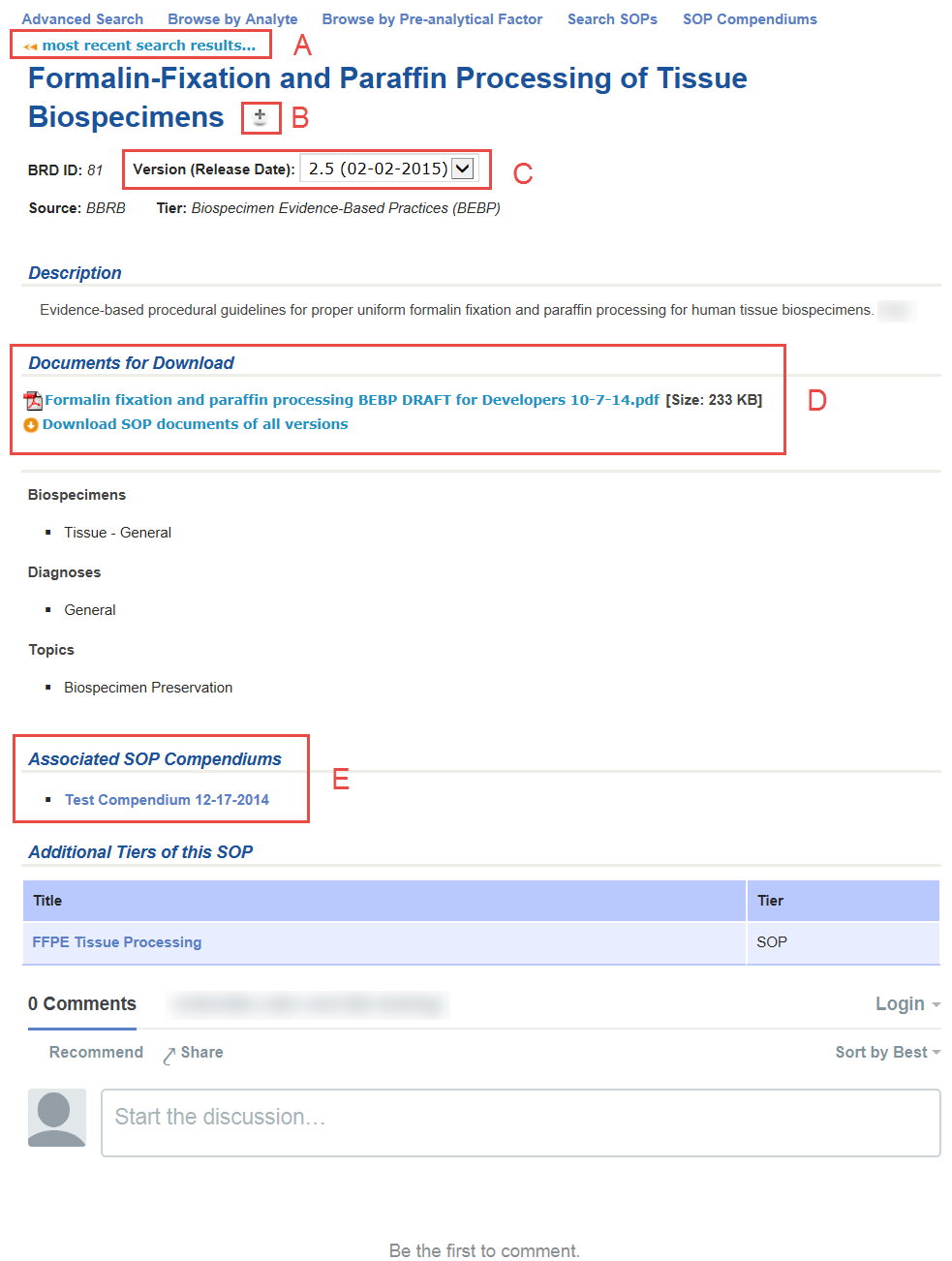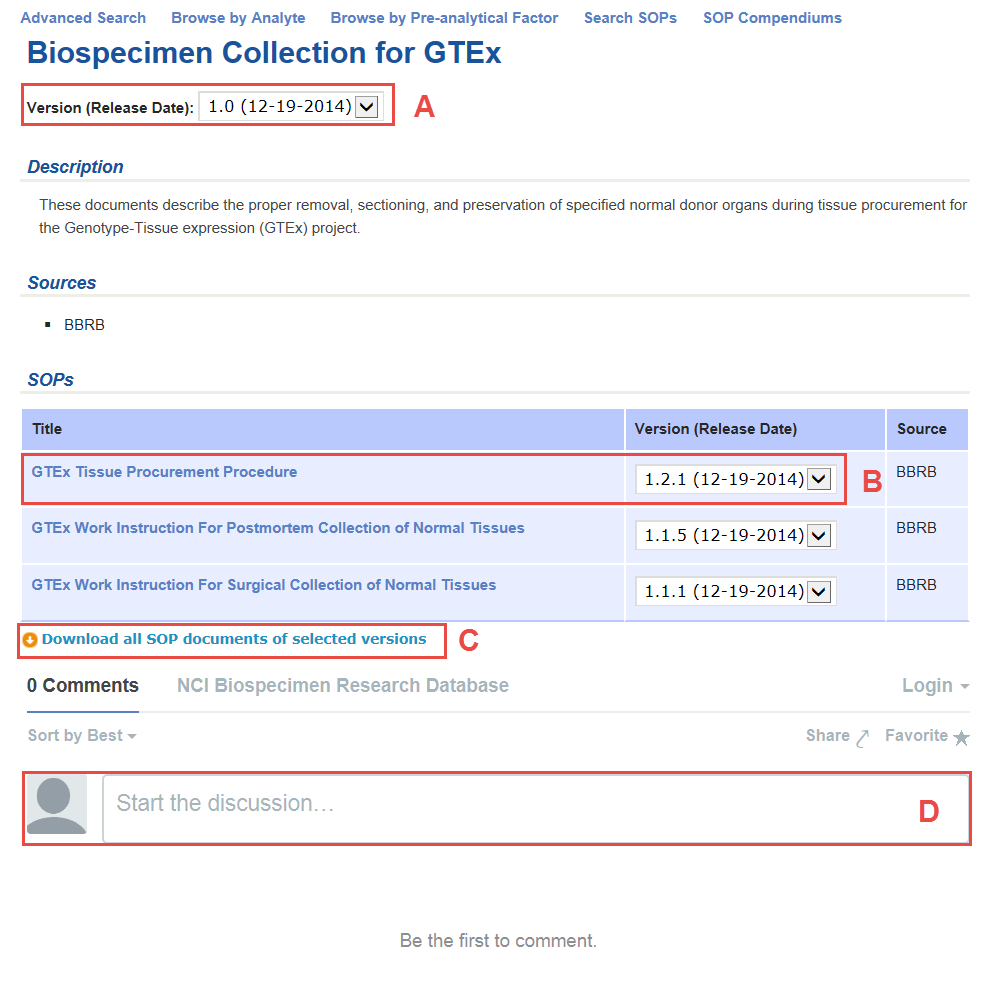 |
Page History
...
Clicking an SOP on the Search SOPs Results page opens the Show SOP page, where you can view a detailed description of the SOP and download associated SOP files.
...
- Search for SOPs.
The Search SOPs Results page appears. Click an SOP title link.
The Show SOP page appears.
Info title Return to the search results Return to the search results by clicking most recent search results... (A) at the top-left of the page.
- Note the following information about the SOP on this page:
- The BRD ID is unique for this version of the SOP.
- You can select a different version of this SOP from the Version (Release Date) list (B).
- The source of the SOP is listed.
- The tier (SOP, Biospecimen Evidence-Based Practices, or Expert-vetted) of this SOP is listed. The SOP can progress to a higher tier.
- A description of the SOP is listed.
- Biospecimen types and locations, diagnoses, diagnosis subcategories, and topics represented in the SOP are listed.
- Download the documents associated with this SOP by clicking links under Documents for Download (C). Files listed here are either in Adobe Acrobat or Microsoft Word format.
- If more than one version of an SOP exists, click Download SOP documents of all versions instead to download a ZIP file of all SOP documents.
- If the SOP is part of a larger compendium or family of SOPs, click the links under Associated SOP Compendiums (D). If the SOP is not associated with a compendium, this section does not appear.
- If the SOP is related to another SOP of a higher or lower tier, click the links under Additional Tiers of this SOP. For example, if an SOP were promoted to the Biospecimen Evidence-Based Practices tier, creating a new SOP, the relationship between the two SOPs would appear in this section. If the SOP does not have a relationship to another SOP, this section does not appear.
...
To add a comment to an SOP
- On a Show an SOP page, select the version of the SOP to which you want to add your comment.
- Scroll to the bottom of the page to the comment box.
Click the arrow next to Login and select the method by which you would like to log in: Disqus, Facebook, Twitter, or Google.
- Follow the prompts to either create and log in with a Disqus account, log in with an existing Disqus account, or log in with a social media account. If you choose a social media account, you merge that account with Disqus and can log in with those credentials each time you want to comment.
- In the comment box, enter your comment. If you have not yet logged in, the application prompts you to log in using one of the methods in the previous step.
- Click Post to complete the comment.
- Optionally, sort the comments, share them on social media, and make the SOP a favorite.
To sort the comments, select one of the following options from the Sort by list:
...
- Sort the list by title or release date by clicking the respective column heading.
- Click an SOP title link to see the details for the SOP on the Show SOP page.
...
- Open the SOP Compendiums page.
- Click a compendium in the list.
The Show SOP Compendium page appears.
You can do the following on this page:
...
To add a comment to a compendium
- Open a Show SOP Compendium page .
- Select the version of the compendium to which you want to add your comment.
- Scroll to the bottom of the page to the comment box.
Click the arrow next to Login and select the method by which you would like to log in: Disqus, Facebook, Twitter, or Google.
- Follow the prompts to either create and log in with a Disqus account, log in with an existing Disqus account, or log in with a social media account. If you choose a social media account, you merge that account with Disqus and can log in with those credentials each time you want to comment.
- In the comment box, enter your comment. If you have not yet logged in, the application prompts you to log in using one of the methods in the previous step.
- Click Post to complete the comment.
- Optionally, sort the comments, share them on social media, and make the compendium a favorite.
To sort the comments, select one of the following options from the Sort by list:
...






